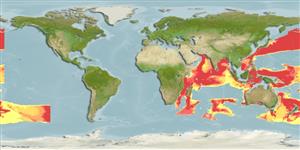Common names from other countries
>
Tetraodontiformes (Puffers and filefishes) >
Triacanthodidae (Spikefishes) > Triacanthodinae
Etymology: Atrophacanthus: Greek, atrophos, -os, -os = not edible + Greek, akantha = thorn; Atrophos has also the meaning of languid, exhausted (Ref. 45335).
Environment: milieu / climate zone / depth range / distribution range
Ekologi
laut batipelagis; kisaran kedalaman 300 - 2000 m (Ref. 557). Deep-water
Indo-West Pacific: Japan, the Philippines, Celebes Sea, off Tanzania, and probably in South Africa.
Size / Weight / umur
Maturity: Lm ? range ? - ? cm
Max length : 4.4 cm SL jantan/; (Ref. 557)
Life cycle and mating behavior
Kematangan | Reproduksi, perkembang biakan | Pemijahan | telur-telur | Fecundity | Larva
Tyler, J.C., 1986. Triacanthodidae. p. 887-890. In M.M. Smith and P.C. Heemstra (eds.) Smiths' sea fishes. Springer-Verlag, Berlin. (Ref. 6660)
Status IUCN Red List (Ref. 130435)
CITES (Ref. 128078)
Not Evaluated
ancaman kepada manusia
Harmless
penggunaan manusia
informasi lanjut
AcuanBudidaya airprofil budidaya airStrainGenetikaElectrophoresesDiturunkanPenyakit-penyakitPengolahanMass conversion
mitraGambarStamps, Coins Misc.Suara-suaraCiguateraKecepatanTipe renangArea insangOtolithsOtakPenglihatan / visi
Alat, peralatan
laporan khas
muat turun XML
Sumber internet
Estimates based on models
Preferred temperature (Ref.
115969): 2.4 - 9.1, mean 6.1 (based on 998 cells).
Phylogenetic diversity index (Ref.
82804): PD
50 = 1.0000 [Uniqueness, from 0.5 = low to 2.0 = high].
Bayesian length-weight: a=0.01122 (0.00514 - 0.02450), b=3.04 (2.87 - 3.21), in cm Total Length, based on all LWR estimates for this body shape (Ref.
93245).
Trophic level (Ref.
69278): 3.7 ±0.7 se; based on size and trophs of closest relatives
Fishing Vulnerability (Ref.
59153): Low vulnerability (10 of 100).
